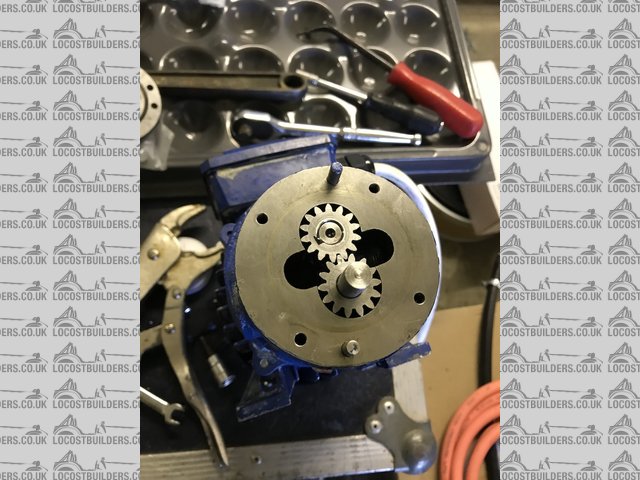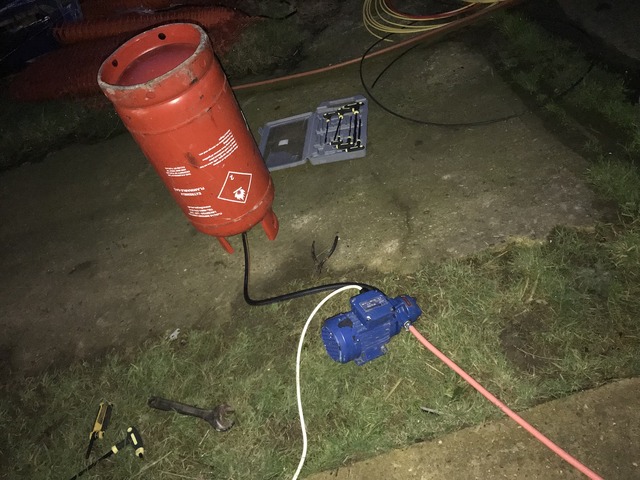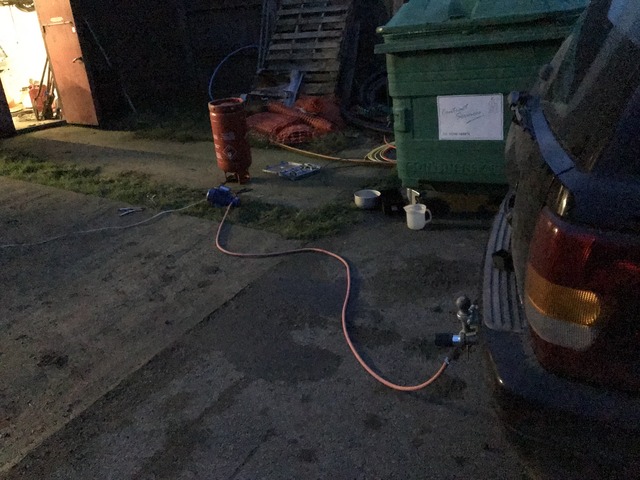ChrisW
|
| posted on 8/1/18 at 04:24 PM |

|
|
quote:
Originally posted by chillis
I believe you need a licence for filling vehicles with LPG. The LGP 'petrol' station will have one issued by the local fire brigade.
As far as I am aware this only applies to commercial use, the same as for petrol.
My gaff my rules
|
|
|
|
|
daviep
|
| posted on 8/1/18 at 05:03 PM |

|
|
FYI, gear pump will have a rubber seal on the driveshaft and also the end plates will be sealed using rubber seals. Should you need to reseal then
kits are usually available in Viton which is compatible with LPG.
How will you drive the pump?
Very interests in the outcome of this.
Regards
Davies
“A truly great library contains something in it to offend everyone.”
|
|
|
ChrisW
|
| posted on 8/1/18 at 06:10 PM |

|
|
quote:
Originally posted by daviep
FYI, gear pump will have a rubber seal on the driveshaft and also the end plates will be sealed using rubber seals. Should you need to reseal then
kits are usually available in Viton which is compatible with LPG.
How will you drive the pump?
Thanks for the info. The manufacturer doesn't state the material used for the seals just that they are 'compatible with the pumped
fluid'.
Pump is electrically powered, 3 phase. I have ordered a suitable contactor today to control it and will wire it up with a momentary switch.
Chris
My gaff my rules
|
|
|
ChrisW
|
| posted on 12/1/18 at 11:58 AM |

|
|
Update: got all the big parts here. Need a trip to Screwfix to get some jubilee clips and to knock something up to safely activate the contactor at a
safe distance from where gas has the potential to escape.
 
lpg pump bits
Have also got a 19kg orange cylinder to use as my first test. Actually more expensive per litre than buying 'real' LPG but it means I can
try the rig out without loosing too much money if it doesn't work. See previous posts for the reason why I have selected 19kg as the first
trial.
Only problem now is I have a full tank of gas in the car so it will be a couple of days before I can try this all out. If you see a mushroom cloud
over a North Buckinghamshire farm you will know why! 
Chris
My gaff my rules
|
|
|
gremlin1234
|
| posted on 12/1/18 at 12:32 PM |

|
|
quote:
Originally posted by ChrisW
Need a trip to Screwfix to get some jubilee clips
I've seen lots of things saying not to use jubilee clips on fuel hoses since they tend not to clamp evenly all round
|
|
|
ChrisW
|
| posted on 12/1/18 at 12:52 PM |

|
|
quote:
Originally posted by gremlin1234
quote:
Originally posted by ChrisW
Need a trip to Screwfix to get some jubilee clips
I've seen lots of things saying not to use jubilee clips on fuel hoses since they tend not to clamp evenly all round
Interesting, thanks. I actually have the tool for O-clips. Perhaps better to use those instead.
My gaff my rules
|
|
|
Mr Whippy
|
| posted on 12/1/18 at 01:01 PM |

|
|
yeah...he's still alive 
|
|
|
ChrisW
|
| posted on 13/1/18 at 06:34 PM |

|
|
Ok, so for anyone following along at home I have had some success (I think) with this tonight.
First problem I came across was it appeared the pump was not gas tight. I took it apart to find out why (I figured I had nothing to loose) and it
seems the rear seal was not seated correctly. If you are interested, here is what it looks like inside.
 
LPG rig test 3
I cleaned everything out, wiped out the remnants of hydraulic oil, and put it all back together. All seemed good from both a sniff test (no gas
smell) and ear test (can't hear any hissing). Next time I go up to the yard I will take some fairy liquid and double check that there are no
weeps from anywhere.
It is worth saying that I had the pump on about 10m of cable so I could stand well back and activate it just in case anything bad happened. The down
side of this was I was I could not hear if anything was going wrong, any gas escaping, etc whilst operating the pump.
So anyway, I hooked everything up but didn't connect to the car, and tested running the pump to see if I could get it to prime. It seems there
is some kind of stop valve mechanism in the propane tank fitting that I managed to activate the first time I tried, I think because I was being very
cautious about opening all the valves at once and probably managed to create a vacuum somewhere. The second time I just opened all but the valve on
the car filler end, ran the pump for a few seconds and hey presto I had liquid when I cracked open the valve at the car filler end.
 
LPG rig test 2
Then hooked it up to the car and weighed the cylinder so I had a starting position. Ran the pump for a few seconds, went over and checked for any
signs of leaks, few more seconds, re-check, etc. Did that until I had 30 seconds of pump run time. Checked the cylinder and the weight had dropped
indicating transfer of gas. Started running for longer bursts. First 10 seconds at a time, then 20s, then 30s, then eventually a minute at a time
checking cylinder weight between each run.
Should also say at this point the car was not empty so I wasn't able to say with accuracy how much space was in the tank. As I have no pressure
relief at the moment it was important that I did not get to the limit of the car tank's fill valve. I took a conservative estimate of the gas
used since the last fill (based on miles) and halved that to set a max I was going to attempt to fill today.
 
LPG rig test 1
Sorry the pic is a bit dark.
Anyway, upshot of all of this was that after 6 minutes of total pump run time the propane tank was 6.5kg lighter than when I started indicating 13
litres of gas had been transferred. That is a pretty poor flow rate, about half what the manufacturer claims. That might be because the flow rate is
for hydraulic oil which is far more viscous, because the pump is old and the tolerances in the housing are not what they used to be, or because that 6
minutes was made up of short duration pulses. Who knows, but it will do for now.
So there we go: yes, it is possible to DIY fill from a cylinder without spending thousands or going up in a mushroom cloud.
Next step is to run the car completely out of gas and attempt to pump the rest of the orange cylinder in.
After that, hook up some kind of pressure relief so that I can't overfill the car tank. I have not been able to find any data about how much
pressure the tank stop valve can take but the relief valve at my local (retail) filling station is set to 75psi so I guess I use that as a guide,
perhaps start at 50psi and turn it up from there.
After that, get some bigger cylinders and try to pump into the bulk tank so I can prove that filling from the bulk tank into the car works without
having to invest a few hundred in a full fill.
(Edit to fix spelling mistake)
[Edited on 13/1/2018 by ChrisW]
My gaff my rules
|
|
|
sebastiaan
|
| posted on 13/1/18 at 07:15 PM |

|
|
Right, you lived to tell the tale. As you are going to do this anyway (bad idea) and asked for tips instead of silence:
1) use hydraulic hose. Anything you use needs to be rated to at least 50-100 bar or thereabouts (I'm not talking legislation/rules here, just
experience and common sense) Hydraulic hose works and is cheapish.
2) the pump will be cavitating at the inlet with that thin supply line and the valve(s?) in between. This will cause the low flow and pump wear. Low
flow is also caused by the out-of-spec viscosity of LPG. Being much thinner than the design fluids, the pump will leak more internally. The low flow
problems will get worse on lung runs if the pump starts to warm up. Once/if the pump gets to a temperature sufficiently high enough above the tank
temperature, there will not be liquid at the pump inlet anymore (the gas will have evaporated) and the pump wont pump anything anymore. Best solution:
put the pump inside the tank submerged. Next best option: heat the tank (slowly and carefully, a heat mat on a thermostat will do, but you need a lot
of heat for a 1000L tank. Next next best: fit bigger lines upstream of the pump to lower the pressure drop over them. If you will or will not have
problems depends on how much the pump is cooled by the fuel flow and the pump efficiency. If you are lucky, the pump will stay cold enough to
function. Just dont be surprised if this happens at some point.
3) Safety: you need a pressure relief on all parts of the system, that can be "locked out" (i.e. closed at both ends). Ideally a shut off
that will allow backflow into the tank, but not out of it. This is also how the automotive LPG lockoffs work.
4) Safety: get, use and hardwire in a gas dectector that shuts off everything when it senses gas. Yes, this means there needs to be an electrical cut
off at the main tank as well.
5) Safety: draw up a working procedure around safety and checks and FOLLOW IT RIGOUROUSLY and ALWAYS. Human error will get you killed.
6) Safety: install a dry break coupling in the fuel hose to the car. See also #5. Yes, people drive away from the pump with the hose still connected.
Often...
That should get you part of the way there, should you still really want to. Good luck.
|
|
|













